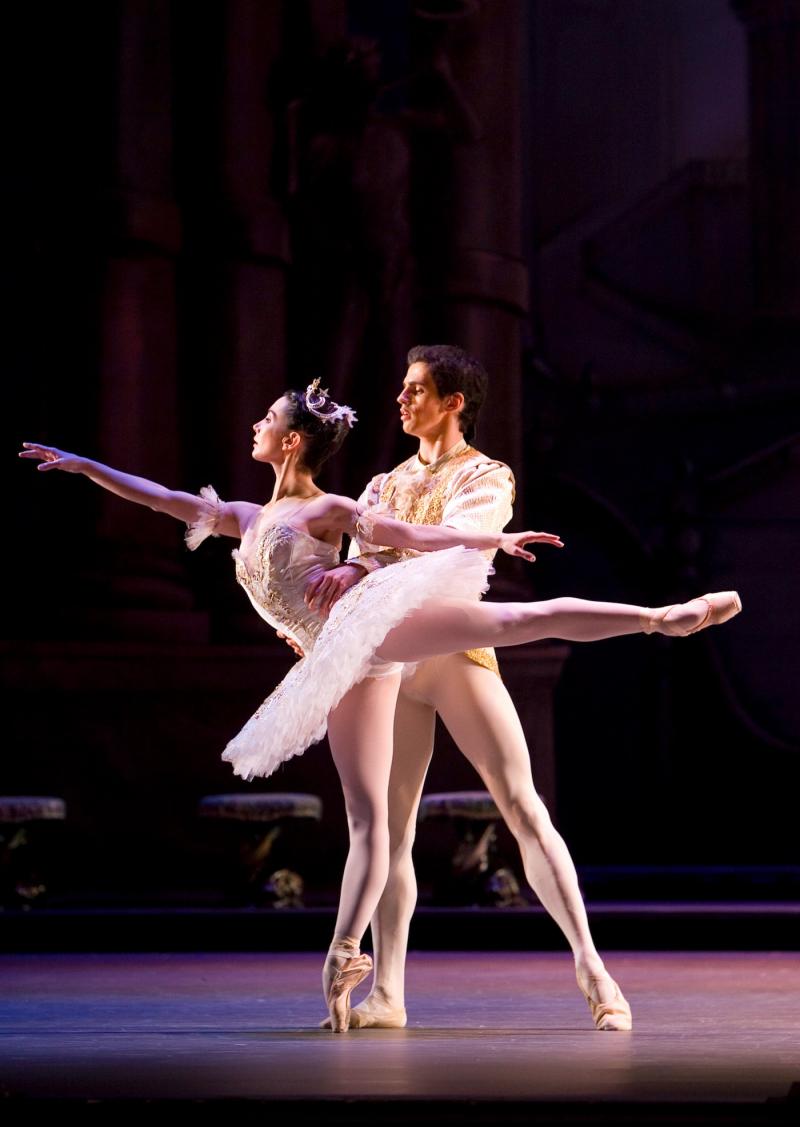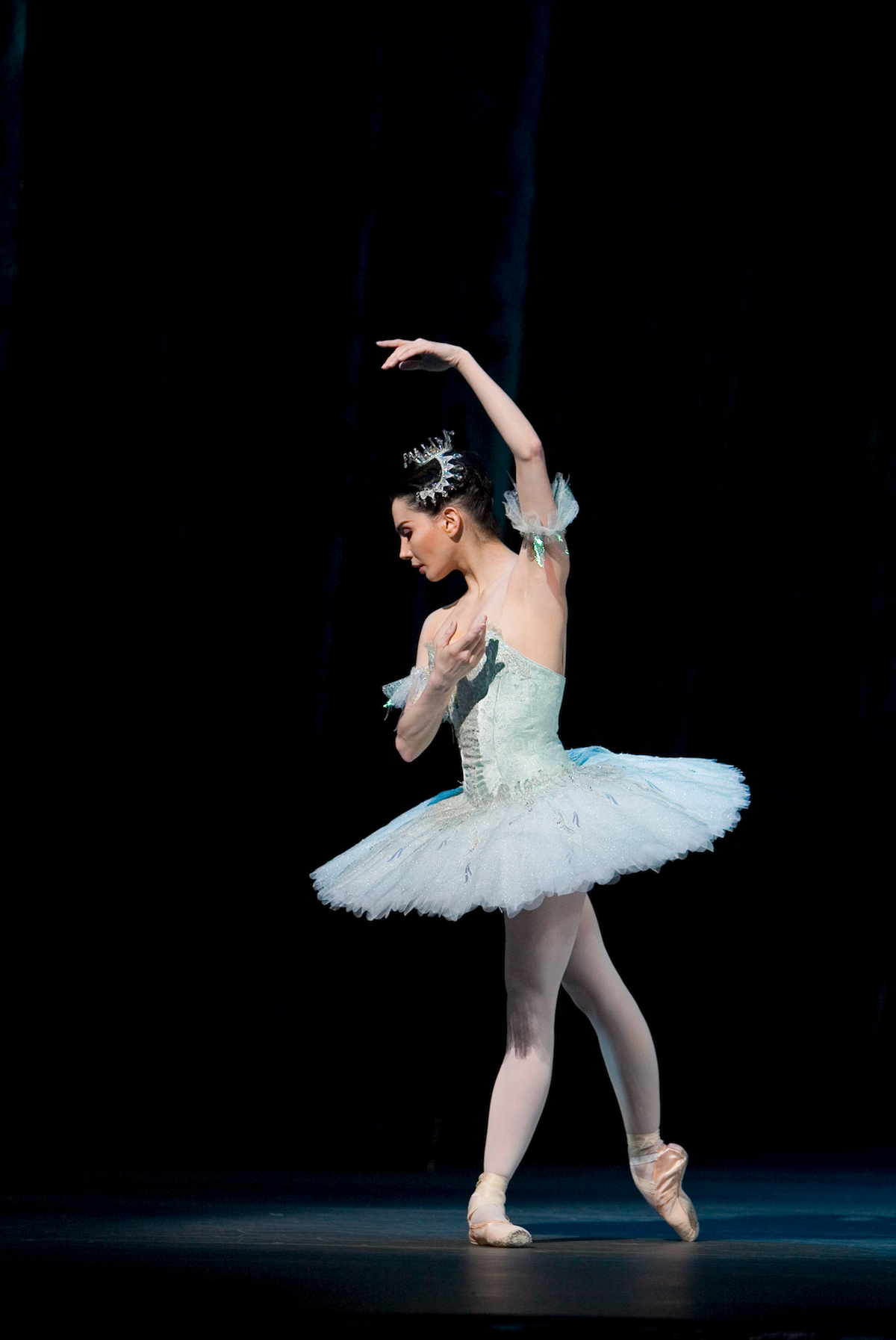The Sleeping Beauty, Royal Ballet | reviews, news & interviews
The Sleeping Beauty, Royal Ballet
The Sleeping Beauty, Royal Ballet
Yet another redesign makes the famously luxurious ballet a total Forties tribute

The Sleeping Beauty was the ballet that kissed the then Sadler’s Wells Ballet into stardom in 1946; after a string of poorly conceived Beauty productions, today’s Royal Ballet hurtled back 60 years in 2006 to try to recapture some of that historic Forties magic in its current staging of this most awesome and enchanting of the classical ballets.
Being a tribute show, rather than a statement of where Beauty is at these days (as the 1990s production designed by the late Maria Björnson was), this version offers the intelligent, aware dancer something paradoxically rather stimulating - the challenge to dance with a feel for the period of Margot Fonteyn. Last night’s wasn’t the first of the run, but its cast was the most interesting one, for into this fragrant, floriferous Forties time warp Tamara Rojo and Federico Bonelli fit like gorgeous matinee movie stars, he with his smouldering Montgomery Clift looks and she with her little, black-haired Liz Taylor sensuality. Bonelli’s gentlemanly grace is something of yesteryear, while the retrospective feel gives Rojo an opulent context which she appears to relish, disguising her highly polished 21st-century technique in her juicy feminine physique like an architect applying scrolls and cherubic ornament to perfectly pure classical line.
 The great English choreographer Frederick Ashton used to watch The Sleeping Beauty over and over, “taking private lessons”, in his famous phrase; Rojo gives her own lessons in interpretation of this totemic and two-dimensional fairyland Princess, using her back and neck with lovely eloquence to show the evolution of her character’s life through Tchaikovsky’s ravishing, instinctual music. Fascinating to see the freedom of pace with which she treated her pre-sleep solo, the one with the violin after the Rose Adagio, which she danced with the improvisatory rubato of a cadenza. And during her sleep, in the Vision Scene, she used those large repeated leg lifts like signals of readiness for awakening, their erotic message underlined by contrast with the demure skipping of the nymphs attending her.
The great English choreographer Frederick Ashton used to watch The Sleeping Beauty over and over, “taking private lessons”, in his famous phrase; Rojo gives her own lessons in interpretation of this totemic and two-dimensional fairyland Princess, using her back and neck with lovely eloquence to show the evolution of her character’s life through Tchaikovsky’s ravishing, instinctual music. Fascinating to see the freedom of pace with which she treated her pre-sleep solo, the one with the violin after the Rose Adagio, which she danced with the improvisatory rubato of a cadenza. And during her sleep, in the Vision Scene, she used those large repeated leg lifts like signals of readiness for awakening, their erotic message underlined by contrast with the demure skipping of the nymphs attending her.
Rojo is something of a one-off in this kind of in-the-moment imaginative recreation. Certainly she was on another plane of classical mastery from anyone else on stage apart from the ever-promising Yuhui Choe, a melodious Fairy of the Crystal Fountain in the Prologue and a delectable, flyaway Princess Florine in the Bluebird duet in Act III. Both these women have trained themselves to place their pointed feet to the ground as if brushing ink onto parchment - only with that kind of perfectionist foot skill can all those feminine fairies with their tiny, telling solos live up to their job descriptions, which none of the others did sufficiently, too stiff of back and clumpy on their toes.
You imagine Rojo's Princess becoming Aurora the Great in timeIf handsome Bonelli could stretch just an extra inch in every movement, add the last 10 per cent in fantasy and intensity, his fine proportions and gentle, accurate musicality would become remarkable. He is, you sense from his demeanour, a relatively minor Prince, and Rojo’s Princess Aurora (who represents in the libretto the daughter of the Sun King, Louis XIV) is evidently her father’s child in potential majesty. Had she not pricked her finger, she might well have found a more combative match in one of the frothily costumed quartet of international aristocrats offering their hands to her on her 16th birthday. You imagine Rojo's Princess becoming Aurora the Great in time.
The production has two distinctly different looks, the Baroque-style of Aurora's palace contrasted with the misty Impressionistic outdoors where the Prince goes hunting a century later, and why not? The shifting scenery for his magical journey by boat to find the sleeping beauty is so well done that its odd juxtaposition of chiffony green nymphs with the clearly Baroque-style Aurora and Lilac Fairy is just one of those things. Farmer's homage to Messel's originals is full of lush detail, the pillars of the palace gardens are ringed with decorative bands, mature trees shade the stone courtyard, and the courtiers’ revised livery, with their new Forties Messel styling, glows with floral colours, iris blue, rudbeckia yellow, rose apricot, in faintly Disney-ish swagged cut (but then Messel's era was also Disney's era).
The fairies now all look quite different from each other, with asymmetric toppings to their tutus, strewn individually like bowls of flowers, with delightful little headdresses. Some combinations hark back 20 years to the Ballets Russes palettes on which Messel trained, emerald green and coral (the court's Master of Ceremonies), bronze-yellow with grape-red (the fairy of the Golden Vine), or damson/white/blueberry for the Lilac Fairy (who has pretty little puffs of silver feathers on her shoulders). It is not as surprising and idiosyncratic a display as the Mariinsky's magnificent 1999 recreation of Petipa's own 1890 production, but picturesque it is, and the Royal Opera House orchestra was conducted in stately happiness by Boris Gruzin.
Still, The Sleeping Beauty is about more than pictures - it's at once mythic as a fable, magnificent as a multimedia theatrical work of its day, and the highest possible challenge to a troupe's finesse and individual skills from top to toe. If a production must be retrospective, I wish the dancing style were adjusted company-wide to bring out its juices and flavours. Petipa's choreography was taken to the Sadler's Wells Ballet originally by Petipa's own pernickety balletmaster, Nikolai Sergeyev, and he was famously a dragon for execution. He would have snorted flames last night at the lack of unified tailoring finish. I wish the men, who beat their feet efficiently, would also point them as if they knew the huge difference it would make; I wish the fairies, who tilt their heads with nice hauteur, did not have such an ill assortment of bunched hand-shapes. Shortcomings were epitomised in the Lilac Fairy (Itziar Mendizabal) and Bluebird (Alexander Campbell). In these roles you demand something out of this world, ethereal brilliance in him, wise sumptuousness in her, not rawness in both.
Explore topics
Share this article
The future of Arts Journalism
You can stop theartsdesk.com closing!
We urgently need financing to survive. Our fundraising drive has thus far raised £49,000 but we need to reach £100,000 or we will be forced to close. Please contribute here: https://gofund.me/c3f6033d
And if you can forward this information to anyone who might assist, we’d be grateful.

Subscribe to theartsdesk.com
Thank you for continuing to read our work on theartsdesk.com. For unlimited access to every article in its entirety, including our archive of more than 15,000 pieces, we're asking for £5 per month or £40 per year. We feel it's a very good deal, and hope you do too.
To take a subscription now simply click here.
And if you're looking for that extra gift for a friend or family member, why not treat them to a theartsdesk.com gift subscription?
more Dance
 'We are bowled over!' Thank you for your messages of love and support
Much-appreciated words of commendation from readers and the cultural community
'We are bowled over!' Thank you for your messages of love and support
Much-appreciated words of commendation from readers and the cultural community
 R:Evolution, English National Ballet, Sadler's Wells review - a vibrant survey of ballet in four acts
ENB set the bar high with this mixed bill, but they meet its challenges thrillingly
R:Evolution, English National Ballet, Sadler's Wells review - a vibrant survey of ballet in four acts
ENB set the bar high with this mixed bill, but they meet its challenges thrillingly
 Like Water for Chocolate, Royal Ballet review - splendid dancing and sets, but there's too much plot
Christopher Wheeldon's version looks great but is too muddling to connect with fully
Like Water for Chocolate, Royal Ballet review - splendid dancing and sets, but there's too much plot
Christopher Wheeldon's version looks great but is too muddling to connect with fully
 iD-Reloaded, Cirque Éloize, Marlowe Theatre, Canterbury review - attitude, energy and invention
A riotous blend of urban dance music, hip hop and contemporary circus
iD-Reloaded, Cirque Éloize, Marlowe Theatre, Canterbury review - attitude, energy and invention
A riotous blend of urban dance music, hip hop and contemporary circus
 How to be a Dancer in 72,000 Easy Lessons, Teaċ Daṁsa review - a riveting account of a life in dance
Michael Keegan-Dolan's unique hybrid of physical theatre and comic monologue
How to be a Dancer in 72,000 Easy Lessons, Teaċ Daṁsa review - a riveting account of a life in dance
Michael Keegan-Dolan's unique hybrid of physical theatre and comic monologue
 A Single Man, Linbury Theatre review - an anatomy of melancholy, with breaks in the clouds
Ed Watson and Jonathan Goddard are extraordinary in Jonathan Watkins' dance theatre adaptation of Isherwood's novel
A Single Man, Linbury Theatre review - an anatomy of melancholy, with breaks in the clouds
Ed Watson and Jonathan Goddard are extraordinary in Jonathan Watkins' dance theatre adaptation of Isherwood's novel
 Peaky Blinders: The Redemption of Thomas Shelby, Rambert, Sadler's Wells review - exciting dancing, if you can see it
Six TV series reduced to 100 minutes' dance time doesn't quite compute
Peaky Blinders: The Redemption of Thomas Shelby, Rambert, Sadler's Wells review - exciting dancing, if you can see it
Six TV series reduced to 100 minutes' dance time doesn't quite compute
 Giselle, National Ballet of Japan review - return of a classic, refreshed and impeccably danced
First visit by Miyako Yoshida's company leaves you wanting more
Giselle, National Ballet of Japan review - return of a classic, refreshed and impeccably danced
First visit by Miyako Yoshida's company leaves you wanting more
 Quadrophenia, Sadler's Wells review - missed opportunity to give new stage life to a Who classic
The brilliant cast need a tighter score and a stronger narrative
Quadrophenia, Sadler's Wells review - missed opportunity to give new stage life to a Who classic
The brilliant cast need a tighter score and a stronger narrative
 The Midnight Bell, Sadler's Wells review - a first reprise for one of Matthew Bourne's most compelling shows to date
The after-hours lives of the sad and lonely are drawn with compassion, originality and skill
The Midnight Bell, Sadler's Wells review - a first reprise for one of Matthew Bourne's most compelling shows to date
The after-hours lives of the sad and lonely are drawn with compassion, originality and skill
 Ballet to Broadway: Wheeldon Works, Royal Ballet review - the impressive range and reach of Christopher Wheeldon's craft
The title says it: as dancemaker, as creative magnet, the man clearly works his socks off
Ballet to Broadway: Wheeldon Works, Royal Ballet review - the impressive range and reach of Christopher Wheeldon's craft
The title says it: as dancemaker, as creative magnet, the man clearly works his socks off
 The Forsythe Programme, English National Ballet review - brains, beauty and bravura
Once again the veteran choreographer and maverick William Forsythe raises ENB's game
The Forsythe Programme, English National Ballet review - brains, beauty and bravura
Once again the veteran choreographer and maverick William Forsythe raises ENB's game

Add comment